Research Results: A Multi-state Evaluation Of The Response Of Waterhemp Populations To Dicamba And Glufosinate
TRAVIS WINANS, DR. MANDY D. BISH AND DR. KEVIN BRADLEY
COLUMBIA, MO.
With support from the United Soybean Board, in 2019 and 2020 we conducted a screening of 212 waterhemp populations from 7 different states to characterize their abilities to withstand applications of dicamba and glufosinate. The rationale for evaluating only dicamba and glufosinate in this research was that these are two of the most commonly utilized herbicides for post-emergent control of waterhemp in soybean production in the United States. Currently, there have been no officially documented cases of resistance in waterhemp to either of these herbicides. However, there have been multiple instances where a lack of complete control of waterhemp has been observed with both glufosinate and dicamba. University weed scientists contributed waterhemp populations collected from soybean fields in Missouri, Illinois, Indiana, Louisiana, Nebraska, Ohio, and Tennessee. The counties highlighted in Figure 1 illustrate where we received waterhemp populations from for screening. These waterhemp populations were either suspected to be resistant by the grower, retailer, etc., or were still present in the field at the time of soybean harvest.
A series of greenhouse experiments were conducted to characterize the extent to which any of these populations were able to withstand applications of dicamba or glufosinate. The waterhemp populations were treated with 22 and 44 fl ozs per acre of dicamba and 16 and 32 fl ozs per acre of glufosinate. These rates were selected as a 'discriminating dose' that would help us to identify any potentially resistant populations, but in order to confirm true resistance to either herbicide, a more detailed dose-response would need to be conducted on any of the suspicious population identified in this initial screening. Applications were made once the plants reached 3 to 4 inches in height. Each use rate of glufosinate and dicamba were replicated 4 times for each population. Visual injury ratings and survival counts were taken 21 days after application.
We found that waterhemp survival ranged from 20 to 25 percent when the populations were treated with the 16 fl ozs per acre rate of glufosinate, and a higher survival percentage was observed in 2020 than in 2019 (Figure 2). However, waterhemp survival was less than 10 percent in either year when treated with the 32 fl ozs per acre rate of glufosinate (Figure 2). When we separated out the results from the Missouri populations only, the results were consistent between years, and similar to the overall results observed across all the populations (Figure 3).
For dicamba, the survival percentages were higher, ranging from approximately 28 to 29 percent, and were nearly identical for 2019 and 2020 when treated with the 22 fl ozs per acre rate. When treated with the 44 fl ozs per acre rate, waterhemp survival ranged from 6 to 9 percent and was also similar between years (Figure 4). For Missouri, slightly higher survival percentages were observed in 2020 when treated with both use rates of dicamba (Figure 5).
To be clear, we have not yet confirmed any specific waterhemp population as being resistant to either glufosinate or dicamba in this research. However, several of the 'suspicious' populations that we have identified are being subjected to a more detailed dose-response analysis to see if any herbicide resistances might be present.
Although it is important to characterize and report on new herbicide- resistant weeds when they are found, this research is more of a proactive attempt to understand the response of waterhemp populations from one year to the next, and to determine whether or not we are moving in the direction of wide-scale resistance to glufosinate or dicamba like what has occurred with glyphosate, group 2 herbicides (ALS-inhibitors), and group 14 herbicides (PPO-inhibitors) in the past. Thus far, we have not seen major shifts in the response of the waterhemp populations from one year to the next. An additional set of 111 waterhemp populations were also collected prior to soybean harvest in 2020 and are currently being screened in our greenhouses in the same manner as described previously. Results from this research will be shared widely at all of our field days, grower meetings, and on our social media sites as we finalize them. ∆
TRAVIS WINANS: Student University of Missouri
DR. MANDY D. BISH: Research Specialist, University of Missouri
DR. KEVIN BRADLEY: Professor Plant Sciences, University of Missouri
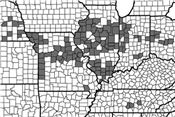
Figure 1 Counties where waterhemp was harvested for screening in Missouri, Illinois, Indiana, Louisiana, Nebraska, Ohio, and Tennessee.
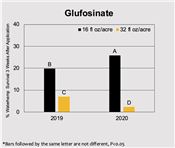
Figure 2 Response of 212 waterhemp populations to 16 and 32 fl ozs/ acre of glufosinate.
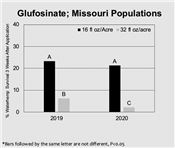
Figure 3 Response of Missouri waterhemp populations to 16 and 32 fl ozs/acre of glufosinate.
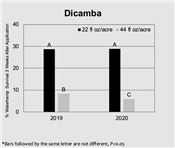
Figure 4 Response of 212 waterhemp populations to 22 and 44 fl ozs/ acre of dicamba.
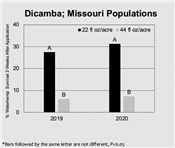
Figure 5 Response of Missouri waterhemp populations to 22 and 44 fl ozs/acre of dicamba.